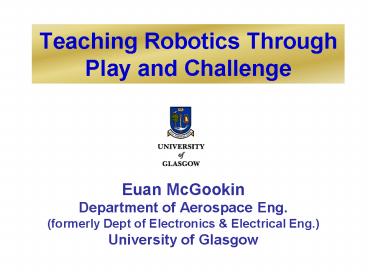Teaching Robotics Through Play and Challenge PowerPoint PPT Presentation
1 / 16
Title: Teaching Robotics Through Play and Challenge
1
Teaching Robotics Through Play and Challenge
- Euan McGookin
- Department of Aerospace Eng.
- (formerly Dept of Electronics Electrical Eng.)
- University of Glasgow
2
Outline
- Robotics Course Structure
- Challenge of Robotics
- Play with Robotics
- Lecturing Approaches
- LEGO Robotics
- Feedback Analysis
- Conclusions
3
Robotics Course Structure
Lectures
Laboratories
Sensors Actuators 20 Lectures
Exam (75)
Competition (25)
4
Lecture Content Challenge
- Highly mathematical robotics content sensors,
actuators, kinematics, dynamics, control and
systems - Theoretical aspects of design and analysis
- Very difficult subject matter to learn and teach
- Requires reinforcement of material to ensure
teaching outcomes are achieved examples and
questions
5
Lab Content Play
- Practical implementation of sensor, actuator and
programming - Introduction of mobile robotics
- Fast prototyping of mobile robots for a
competition either robotic gladiatorial games
or olympics - Team based activities to ensure no individual is
overworked - Fun approach to learning practical concepts which
provides counter balance for the lectures
6
Applying the Challenge
- Engagement with lecture activities and
reinforcement of subject matter ensured through
challenge based approaches to lectures - These are implemented through three techniques
- - Board Work
- - Direct Questioning
- - Mid-lecture Breaks
7
Board Work
- A key part of the robotics course is practical
reinforcement of knowledge through problem based
session in the lecture - These examples are undertaken on the board and
involve all of the student cohort - The initial part of the problem is carried out by
the lecturer, as an example - The rest of the problem is solved by volunteers
selected from the audience - All of the cohort are involved by providing
advice for the volunteer
8
Direct Questioning
- Reinforcing taught subject matter is essential
for achieving the desired pedagogical outcomes of
the lectures - This is achieved through direct questioning at
the beginning and at appropriate points during
the lecture - Selection of student to be questioned is
initially voluntary and then random if no
volunteer is forthcoming - This very stressful approach ensures that the
students engage with the learning process
9
Mid-lecture Break
- The third technique is not a challenge aspect but
provides compensation for the stress of the other
techniques - This involves a mid-lecture break (of a few
minutes) to reinitiate interest in the lecture - The break can take the form of a discussion about
an unrelated topic e.g. a current film review - Such a break is necessary to make sure that the
students feel unthreatened and an informal
environment is established within the lecture
theatre.
10
Initiating Play
- The counterpoint to the challenging lectures is
the robot construction laboratory sessions - In order to ensure that the students do not spend
too much time constructing their robot designs,
LEGO Mindstorm is used - This is a fast prototyping medium for the design
of robotic systems that illustrates some of the
practical constraints of robot manufacturing - Also, the use of LEGO introduces an element of
childlike play into the laboratory session that
provides an enjoyable release from the lectures
11
LEGO Robot Construction
- The Lab sessions involve the construction of LEGO
Mindstorms based robots for a competition i.e.
robot gladiators or olympics - The teams design, construct and programme their
robots so that they are fit for purpose - The rules for the competition specify the
restrictions for the design process
12
LEGO Robots
- LEGO designs for the Gladiatorial Robot
competition
13
Lab Competition
- The final activity for the laboratory sessions
is a competition where students give
presentations and then perform the specific tasks
0.3m
1.5m
2m
THE ARENA
14
Student Feedback
- Student feedback, from questionnaires and small
group discussions, has been positive about this
dual approach to teaching robotics - Most students have participated well in both the
lecture and lab sessions - Attendance and examination results have been very
favourable, indicating that the student have
engaged well with the learning process
15
Finding the Balance
- This dual approach has to be handled carefully as
a balance is needed between the challenge and
play - Too much challenge will cause the students to be
too stressed - Too much play will distract from the learning
outcome of the course - A light, well humoured approach is needed to
ensure success
16
Conclusions
- A success dual approach has been employed in the
teaching of robotics - Challenge ensures that the students engage with
the learning process in lectures - Play ensures that the students have an enjoyable
practical element to the course - Feedback indicates that this approach provides
the necessary learning environment - A balance is needed between challenge and play
for the pedagogical outcomes of the course to be
successfully achieved

